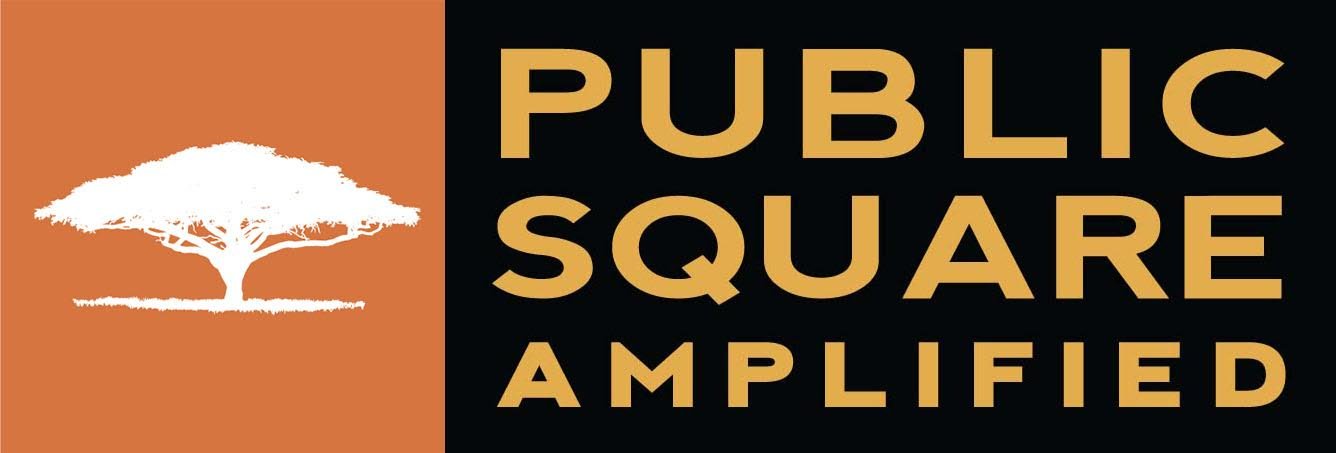How you can apply the true lesson of 2020’s racial justice uprising
Protestors holding banners as they stand on the steps of the Municipal court building for the “Fists across America March” in Newark, NJ on Oct. 22, 2023. (Matt Dragon for Public Square Amplified)
NEWARK, NJ—One of the lessons people might have incorrectly drawn from the 2020 uprising around racial justice in the United States was that it was spurred by a sharp, rapid increase in police violence directed toward Black people. Protesters around the globe were attributing the murder of George Floyd, while technically at the knee of Officer Derek Chauvin, to the entire Minneapolis Police Department and, more widely, to a system of policing that allows the police to enact violence on the communities they’ve sworn to protect and serve. The video of the killing, courageously recorded by a 17-year-old woman, showed millions of Americans what really goes on when an initial police statement announces a “medical incident.”
A study of the history of policing, however, would tell you that lesson was flawed, fatally so. It was not that there was a sudden or even a steady increase of police brutality; but there was an explosion of video proof. While dash cam video had been growing more commonplace for over a decade – then, as police budgets increased, more officers wore cameras on their increasingly militarized body armor – by 2020, almost every person walking down the street had a newscast-quality camera in their pocket.
So it wasn’t that police violence against our Black neighbors was happening with increasing frequency. It was that we white folks were increasingly seeing it – on our screens, in the comfort of our own homes, images searing into our brains. It was high-definition proof of what our Black neighbors had been telling us for decades, if not centuries. Yet there are still those who say that George Floyd caused his own death or that, somehow, those police officers were well within their rights to murder him. They needed to make sure they got home to their families. He was accused of using a counterfeit bill. He was on drugs. He had a criminal record. None of these things justify an extrajudicial execution, of course, but even unambiguous proof is not always enough to shift our opinions or beliefs. Or at least not immediately.
I’ve personally gone on the mental journey toward understanding the two-tiered system of policing that we have constructed, and continue to nurture, in the U.S. Having grown up on the white side of the law, with a neighbor and uncle who were police officers, I readily absorbed the narrative that the police were the good guys. That they protected us – though who is included in that “us”? – from the bad guys. They were that “thin blue line” that protected us from our society's worst impulses. The police regularly visited our school, to befriend, pass out badges, or demonstrate their cool new toys. In the overwhelmingly white bubble I grew up in, I had no concept that this wasn’t the experience of the police for every child, in every community. I’ve since learned how privileged I was, and am, based on nothing more than the color of my skin.
As much as social media and our hyperconnected world may sometimes send our worst impulses into overdrive, it also provides an extremely democratized system for getting people’s stories out into the world. Sometimes those stories are scripted, misrepresent the facts, or are outright disinformation and propaganda. But every story represents a chance to take in, hold, and consider information that you would never have had access to 30, 15, or even 5 years ago.
Our world has been consumed by atrocity, slaughter, and decimation many times before, but what’s changed in the last few years is the ability for everyone to watch it happen in real time.
On October 7, the shape of the atrocities committed in Israel became clear far faster than it could have even a few years ago. The same is true of the ensuing “kidnappings,” “arrests,” or “detainments,” depending on who commits them and who is being held. We have daily satellite updates to monitor how a portion of the world is systematically flattened.
It’s not all propaganda, it’s not all fake, it’s not all inflated, it’s not all lies. Some of it is, for sure, but it can come from governments just as easily as trolls and misinformation farms. Now, though, we don’t need to wait for experts to put boots on the ground. We don’t need to take the word of our military or government spokespeople, because now they’re often viewing the same real-time feed we are. This isn’t some grand conspiracy theory. It’s just a fact of our new reality that the person whose house just exploded is just as quote-worthy as the press hack sitting hundreds of miles away.
So as someone who, through the passage of time, came to be deeply upset by my past opinions, I wish to warn you: Don’t put up walls. Don’t fall back on your mental shortcuts, the things you think you “know” but are really just false memories implanted by years of repetition. Approach yourself, your knowledge, your memories with the same distrust and minimization that you apply to what “those people” say. Listen, learn, and allow yourself the room to shift, even ever so slightly day by day. Know that wherever you stand, you’re likely not as fully informed, or as unequivocally correct as you think you are. Yesterday was a good day to allow yourself to shift. Today is the next best option.

